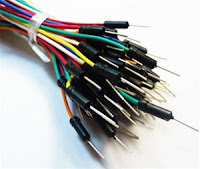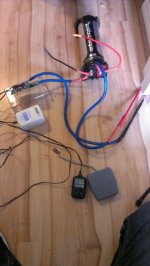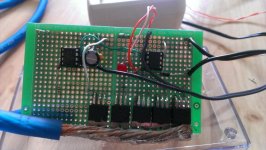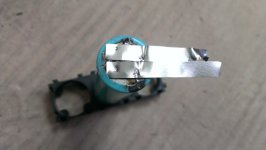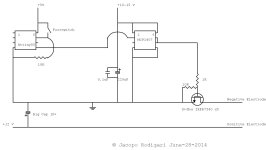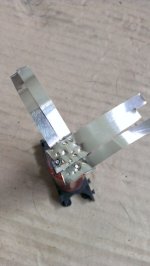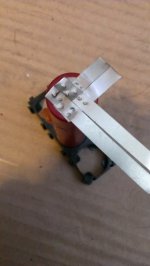crossbreak
1 MW
After some request i now summarize the stuff i learned from schwibsi who built a nice welder and some others, using simple tools.. Posted my progress in his thread, which was a bit OT http://endless-sphere.com/forums/viewtopic.php?f=31&t=50015&start=75#p869087
..sry for that. Now here is room for discussion.
Some more notes:
Using car batteries in dangerous. The 200A fuse i built in DOES NOT PROTECT FROM SERIOUS GINGERY!! I always wear gloves and eye protection when welding.. i dont use it in enclosed rooms and have a fire extinguisher right besides me. Dont blame me if something goes wrong.. i made a lot of faults by my own.. i just post this so you may safe some of your time not doing the same errors as me
-If i knew where to buy cheap, i'd have used 6Farad of caps as power source instead of used car batteries. Sadly Caps are expensive. I would have spend ~150€ for the Caps alone at the bay.
-the arduino code is very rudimentary.. wrote that down in a few minutes.. a lot of room for improvement
-the batteries are not well connected. If I would have gotten a 120ah or bigger one, then i would not have used two small ones but one large instead
After some time using it, i put the stuff into a beer box with some foam to fit the 2 car batteries
..sry for that. Now here is room for discussion.
Some more notes:
Using car batteries in dangerous. The 200A fuse i built in DOES NOT PROTECT FROM SERIOUS GINGERY!! I always wear gloves and eye protection when welding.. i dont use it in enclosed rooms and have a fire extinguisher right besides me. Dont blame me if something goes wrong.. i made a lot of faults by my own.. i just post this so you may safe some of your time not doing the same errors as me
-If i knew where to buy cheap, i'd have used 6Farad of caps as power source instead of used car batteries. Sadly Caps are expensive. I would have spend ~150€ for the Caps alone at the bay.
-the arduino code is very rudimentary.. wrote that down in a few minutes.. a lot of room for improvement
-the batteries are not well connected. If I would have gotten a 120ah or bigger one, then i would not have used two small ones but one large instead
crossbreak said:cool schwibsi. i'll try that as well, using old car batteries i got almost for free (2x Bosch 12/54ah with 560A peak in parallel 1120A ). I have 200pcs of the Sony VTC4 laying on my desk, ready to be wired... wanted to solder but know i wanna give this a try.
I'll have to find a source 6 of for the IRF1324 Fets. any idea? I could also use irfb3077 i have laying around... but i would need at least 12 since they have 2.8mOhms RDSon
Where did you source your irf1324? here in Germany?
I'll use the MCP1407 as a driver (with 100ohm resistors to the FETs) , sound reasonable. Did you use multiple of these?
schwibsi said:Voelkner/Conrad has both, the fet driver and the IRF1324.
DON'T solder the Sony cells.
The fet driver is bad-ass. Just one is required for all 6 fets.
crossbreak said:i tried that already. google sux. thanks! Ordered 6 and a driver for 25€, that's reasonable. With arduino pro mini (8€) a foot button (1€) 1602 lcd (€2.50) some more Buttons, resistors and caps this project will stay below 50€. I think about using an Arduino micro or Attiny 861 instead to be able read a shunt in Diff-Gain-mode to be able to get a guess of the amps an joules that flow. But maybe i just dont need.
I soldered 2 to makes some tests. Got 2.2 - 2.25 ah @ 10amps from 4.22V to 2.7V, restance 17-18 mOhm. Good value IMO. I was very careful when soldering, but it was quite some effort. Welding seems so much easier.DON'T solder the Sony cells.
schwibsi said:It's not just that it's easier.
By soldering on the poles, you heat up the cell chemistry and thereby damage it. As you don't always solder the same, you'll damage them to different degrees, and they will have less life-time or not be drift-free anymore. I would steer clear of solding the cells.
schwibsi said:I would use copper or tungsten for the electrodes and PTFE for the holder.
crossbreak said:my solder tips always melt on the nickel plates... what do i do wrong? Too little current? Tried it with 25ms duration with solder tips as electrodes and a lead acid battery that does ~500A
Edit: The used solder tips are very cheap ones made of a Zinc alloy. Thought they are always made of Copper.. they are not.
I have a paralleled two 40A fuses at the positive wire to protect from short circuits. I'll try a 200A ANL fuse next +a second battery in parrallel. Have you tried wolfram electrodes? Found 4mm dia ones of 99.99% wolfram here http://www.ebay.de/itm/Wolfram-Elek...t=Schweiß_Löttechnik&var=&hash=item1c2f87d955
Hope the wolfram (melts at 3420°C) wont melt on the nickel (melts at 1450°C). It also is a better thermal and electric conductor than nickel.

the SMD gate driver failed after ~500 cells. I use the PDIP version now

This fuse failed, it works with 200A ANL fuse now.

tungsten electrodes failed, now it works with 5mm diameter copper electrodes that are being hold with one hand each


After some time using it, i put the stuff into a beer box with some foam to fit the 2 car batteries




